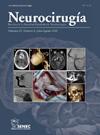超高压阀在持续症状性分流过排中的应用
IF 0.8
4区 医学
Q4 NEUROSCIENCES
引用次数: 0
摘要
导读:分流管过引流是脑室-腹膜分流术的长期并发症之一。难治性病例的治疗可能需要进一步升级阀门开启压力和反虹吸装置。本文的目的是描述这种组合在一组选定的患者的结果。方法回顾性队列研究,纳入2003-2022年间18例儿科患者。以前的分流器被换成了一个sopysa Polaris®SPVA-300阀和升级的固定或可调反重力装置的组合。收集以下变量:脑积水的病因、首次分流术的年龄和瓣膜类型、分流术的翻修次数、其他手术方式、入组时的年龄、临床和放射学结果以及随访时间。对定量变量的均值、中位数和极差进行描述性分析;用于定性数据分析的百分比和频率。结果首次分流术的中位年龄为2个月(0 ~ 67岁)。纳入前的平均分流修正次数为3次。7例患者尝试分流术,但未成功;在两例接受ETV的患者中观察到暂时的成功。两名患者之前有过颅骨扩张。入组时平均年龄为9.1岁(2.7-15.2岁)。分流系统更换升级后,94.4%(17/18)患者临床改善,83.3%(15/18)患者影像学改善。中位随访时间为21个月。结论在考虑更有创性的治疗措施之前,通过超高压阀和升级的在线反虹吸装置联合优化分流系统是治疗难治性症状性分流过引流的有效且安全的策略。本文章由计算机程序翻译,如有差异,请以英文原文为准。
Utility of very high-pressure valves in persistent symptomatic shunt overdrainage
Introduction
Shunt overdrainage is one of the long-term complications associated with ventriculoperitoneal shunts. Treatment of refractory cases may require further upgrading of both the valve opening pressure and antisiphon device. The aim of this paper is to describe the results of this combination in a selected group of patients.
Methods
Retrospective cohort study that included 18 pediatric patients between 2003–2022. Previous shunts were exchanged for the combination of a SOPHYSA Polaris® SPVA-300 valve and upgraded fixed or adjustable antigravitatory devices. The following variables were collected: etiology of the hydrocephalus, age at first shunt and type of valve, number of shunt revisions, other surgical procedures, age at inclusion, clinical and radiological outcomes, and follow-up time. A descriptive analysis was done with means, medians and ranges for quantitative variables; percentages and frequencies for the analysis of qualitative data.
Results
The median age at first shunt was two months (0–67). The mean number of shunt revisions before inclusion was three. Shunt removal was attempted in seven patients without success; temporary success was observed in two patients who underwent ETV. Two patients had previous cranial expansions. The mean age at inclusion was 9.1 years (2.7–15.2). After the shunt system was exchanged and upgraded, clinical improvement was observed in 94.4% (17/18) of patients, and radiological improvement was observed in 83.3% (15/18) of patients. The median follow-up was 21 months.
Conclusions
Before considering more invasive therapeutic measures, shunt system optimization by the combination of very high-pressure valves and upgraded in-line antisiphon devices is a valid and safe strategy for refractory symptomatic shunt overdrainage.
求助全文
通过发布文献求助,成功后即可免费获取论文全文。
去求助
来源期刊

Neurocirugia
医学-神经科学
CiteScore
1.30
自引率
0.00%
发文量
67
审稿时长
60 days
期刊介绍:
Neurocirugía is the official Journal of the Spanish Society of Neurosurgery (SENEC). It is published every 2 months (6 issues per year). Neurocirugía will consider for publication, original clinical and experimental scientific works associated with neurosurgery and other related neurological sciences.
All manuscripts are submitted for review by experts in the field (peer review) and are carried out anonymously (double blind). The Journal accepts works written in Spanish or English.
 求助内容:
求助内容: 应助结果提醒方式:
应助结果提醒方式:


